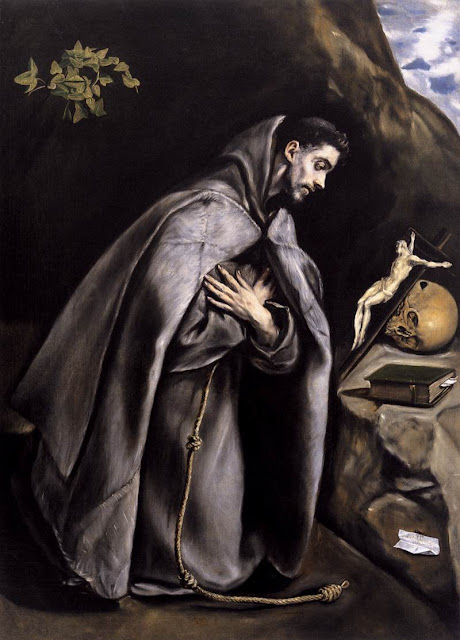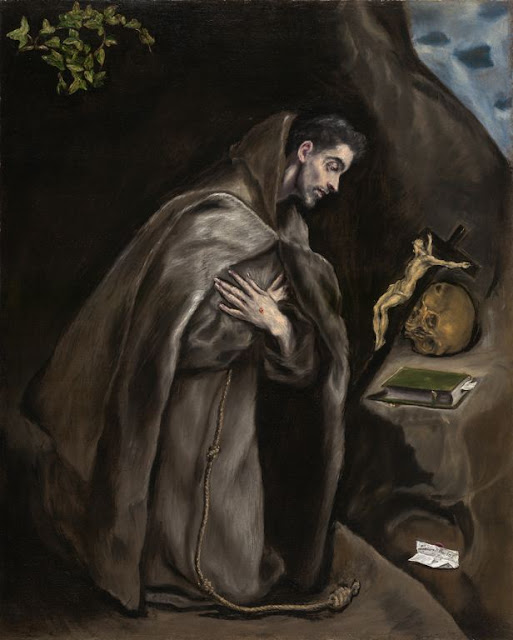Domnikos Theotokpoulos, El Greco(1541-1614)
St Francis Meditating
c. 1595
Oil on canvas, 147,3 x 105,4 cm
Fine Arts Museums of San Francisco, San Francisco
El Greco (Domenikos Theotokopoulos)
1541–1614
Saint Francis Kneeling in Meditation, 1595/1600
Oil on canvas
36 3/16 x 24 1/8 in. (92 x 74 cm); painted surface: 35 1/4 x 28 3/8 in. (89.5 x 72 cm)
Inscribed lower right: Domenikos Theotocopulos (second line of text illegible)
The Art Institute of Chicago
Domnikos Theotokpoulos, El Greco (1541-1614)
Saint Francis kneeling in Meditation c.1605-10
bears traces of a signature (see catalogue note)
oil on canvas
29.7/8 x 25in. (76 x 63.5cm.)
Private collection
St Francis of Assisi was the most popular saint in the Counter-Reformation period.
During his lifetime, El Greco was esteemed as the most effective and prolific painter of the saint.
Pacheco, who served as an official inspector of art works for the Inquisition, asserted that El Greco should be acknowledged as:
"el mejor pintor deste Santo que se hubiera conocido en este tiempo...porque se conformó mejor con lo que dice la historia” (the best painter of this saint that has been known in this time... because he conformed most fully to that which history tells us). Francisco Pacheco, Arte de la pintura (1649), ed. Bonaventura Bassegoda i Hugas (Madrid: Cátedra, 1990), page 698
Representations of Saint Francis constituted a very important part of El Greco’s production — making up approximately ten percent of his oeuvre including that of his workshop. Some authorities suggest that he produced fifty-one paintings of Saint Francis, including eleven that involved substantial collaboration with the workshop.
El Greco and his workshop utilised only ten compositional types.
It was first noted by Francesco Pacheco following his visit to El Greco's studio in 1611, that the artist kept smaller versions (called orginales by Pacheco) of his successful compositions, which were used by himself and his assistants in creating replicas of popular compositions. That was how he maintained a degree of standardisation in his "product".
One popular "theme" or composition was Saint Francis Kneeling in Meditation. The three images above represent this composition.
El Greco shows the full-length figure of the Saint in profile view. He is kneeling with his hands crossed on his chest.
His face is slightly turned to the right away from the viewer. The saint is gazing intently at the crucifix, which leans against a skull on a large, altar-like rock. The crucifix and the skull signify devotion to God and renunciation of worldly things.
The small book is probably a Breviary or a Book of Hours or even Scripture. A paper, projecting from the Book and marks the place of the day’s service. In accordance with devotional practice, Francis has prepared his meditation by first reading.
The saint is shown inside a cave or grotto, which may represent the cell that he built on Mount La Verna.
The outer world has been reduced to a small view of the sky at the upper right.
The hardy ivy vine in the upper left corner is a symbol of salvation and eternal life.
What the artist is attempting to convey about St Francis is contained in the following words of Pope Benedict XVI:
"My dear brothers and sisters, what was the life of the converted Francis if not a great act of love? This is revealed by his passionate prayers, rich in contemplation and praise, his tender embrace of the Divine Child at Greccio, his contemplation of the Passion at La Verna, his living "according to the form of the Holy Gospel" (2 Test. 14), his choice of poverty and his quest for Christ in the faces of the poor.
This was his conversion to Christ, to the point that he sought to be "transformed" into him, becoming his total image; and this explains his typical way of life by virtue of which he appears to us to be so modern, even in comparison with the great themes of our time such as the search for peace, the safeguard of nature, the promotion of dialogue among all people. In these things Francis was a true teacher. However, he was so by starting from Christ.
Indeed, Christ is "our peace" (cf. Eph 2: 14). Christ is the very principle of the cosmos, since through him all things were made (cf. Jn 1: 3). Christ is the divine truth, the eternal "Logos", in which, in time, every "dia-logos" finds its ultimate foundation. Francis profoundly embodies this "Christological" truth which is at the root of human existence, the cosmos and history. "
(Pope Benedict XVI Homily at Mass in the Square outside the Lower Basilica of St Francis Sunday, 17 June 2007 on the Eighth Centenary of the Conversion of St Francis of Assisi)
This aspect of the devotion to St Francis was understood then in Spain and was obviously popular. It struck a chord.
At least eighteen versions of Saint Francis Kneeling in Meditation have been identified, including examples assigned by modern scholars to El Greco; his workshop; his son, Jorge Manuel Theotocopoulos; and contemporary and later followers.
Only the one now in the Fine Arts Museums of San Francisco (pictured above) has been regarded consistently by all modern scholars as an outstanding autograph work by El Greco himself. There are some others such as the one in the Museo de Bellas Artes, Bilbao which are regarded by some as the work of the master himself.
The version of Saint Francis Kneeling in Meditation now in the Art Institute of Chicago (see above) has been attributed variously to the artist, his workshop, and the artist in collaboration with his workshop.
It is thought the work shown above which is in a private collection is a work by the master himself which was either used a model for his workshop, a copy of an existing painting or commission, or a reprise of an earlier composition, painted on commission for clients who wanted certain devotional images on a more intimate scale.
When looking at a painting, there are a number of techniques which are helpful in trying to appreciate it.
One method is to look at very closely at the painting: the viewer and the painting face to face as it were. Then one can see the size of the painting, the painting hopefully in its original frame, the painting from several angles and distances, and the brushwork. It is an experience. However it can be diminished if one only has a short time to visit the museum and one also wants to see a number of ther works. One can only concentrate for so long. If one is seeing too many pictures, "sensory overload" can prevent a proper appreciation. Even if one plans a visit to see only a few paintings, sometimes even in a Museum or Art Gallery this can be difficult especially if it is an important painting and many people want to view the painting. It can also be a tiring process on the feet and the back.
In looking at images of a painting on the net and/or in a book, one misses the immediacy of the real thing. There is only so much that the measurements of the painting and information about the medium can help to envisage the actual painting. It cannot come close to the actual "face to face" experience.
Some museum web sites are very good: the Prado and the Rijksmuseum come quickly to mind. Others even with the horrible "zoom function" leave a lot to be desired. Even some of the premier art galleries in the world seem rather niggardly when it comes to viewing their wares on a web site.
Another method towards appreciation involves looking at different versions of the same composition by the same artist. One looks for the similarities and the differences. This is probably easier using the net and/or books than flying around for example to San Francisco, Chicago and Bilbao.
Another helpful method is to look at a painting in a book through a mirror. It can be quite amazing the amount of detail one can pick up using this simple technique. On the net it is quite simple using software such as Irfan ("horizontal flip"). Here is the San Francisco painting as if in a mirror:
Or even looking at the image as if a negative. This is useful in looking at the lighting of a picture. Here is a "negative" image of the painting in San Francisco:
Most image viewing programmes allow many effects to highlight various parts of an image. As well as being fun, it can also be instructive.






No comments:
Post a Comment